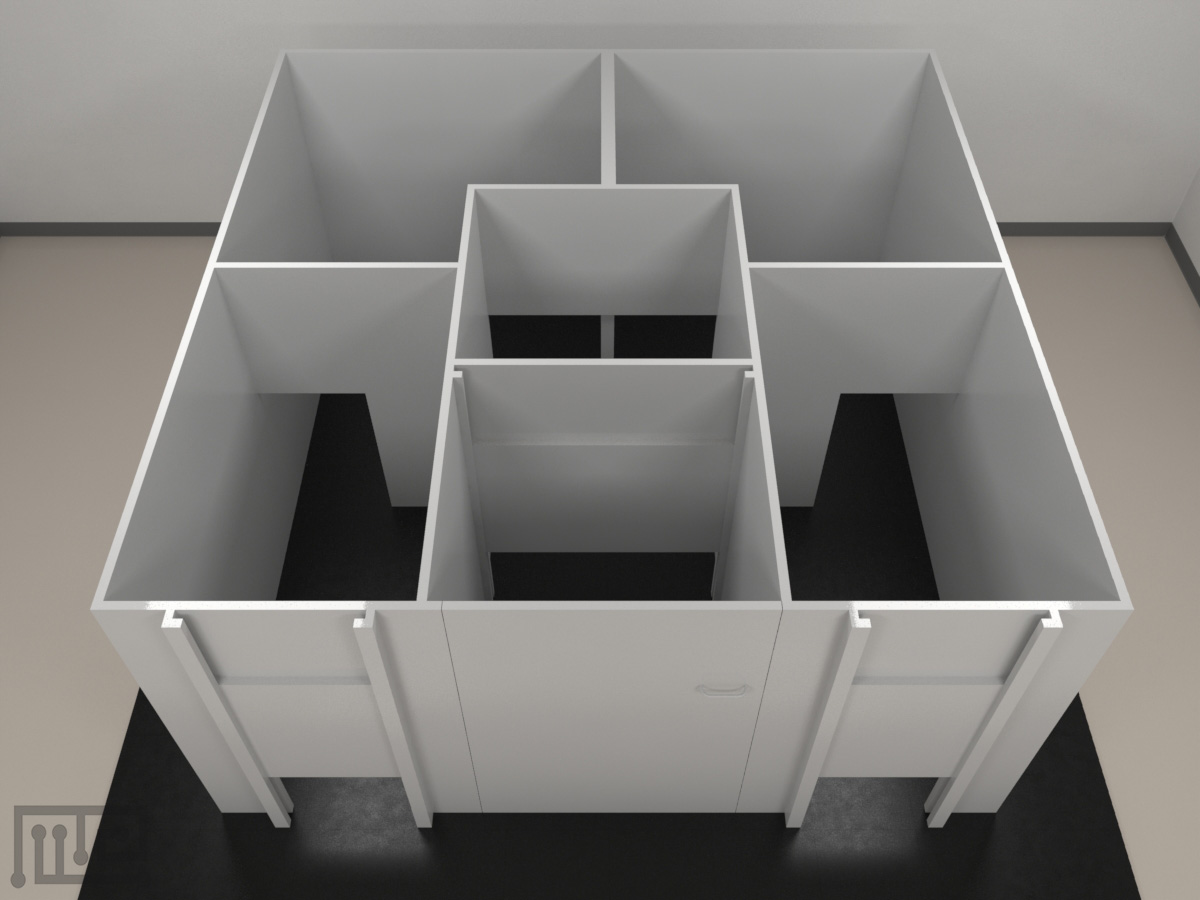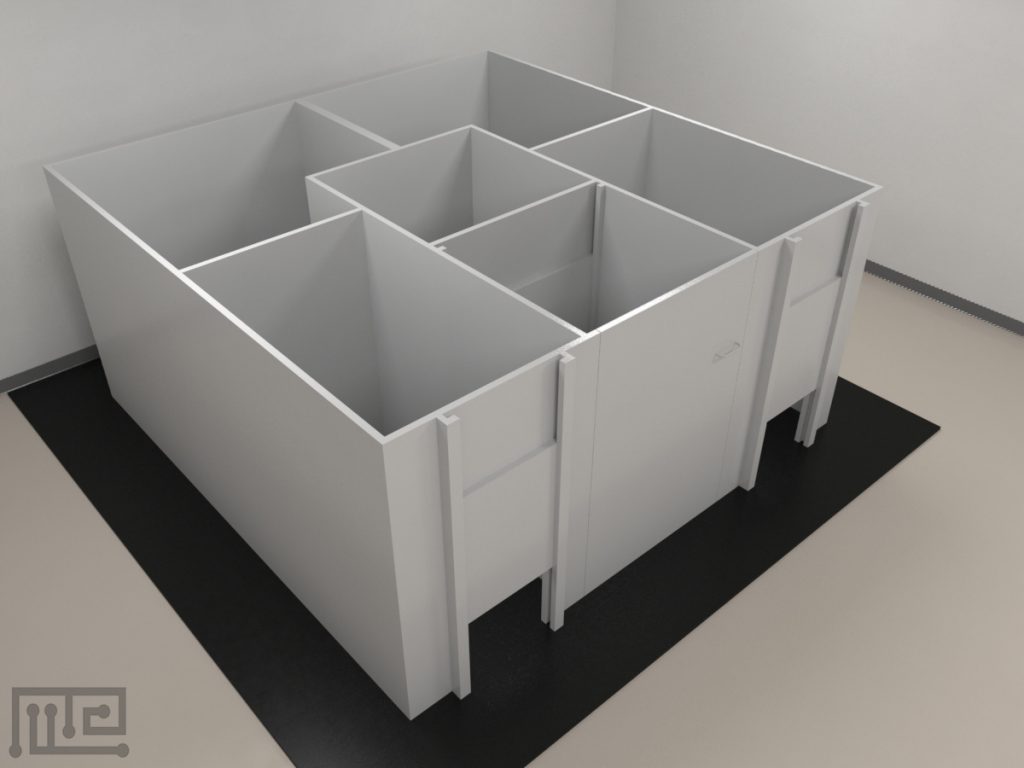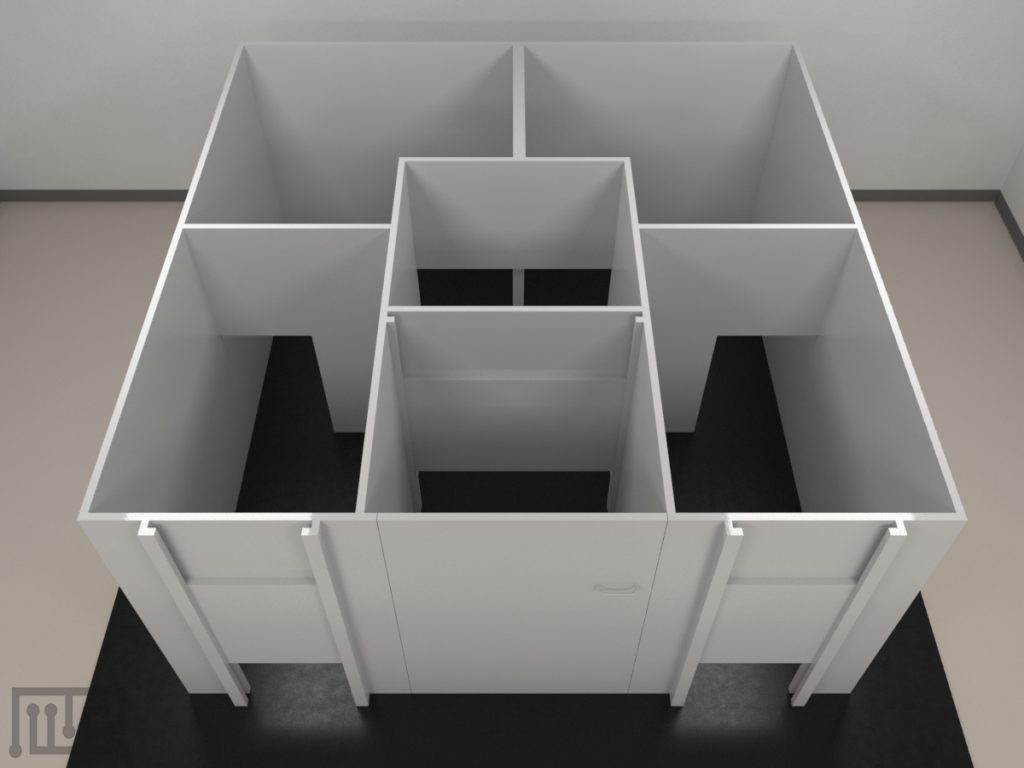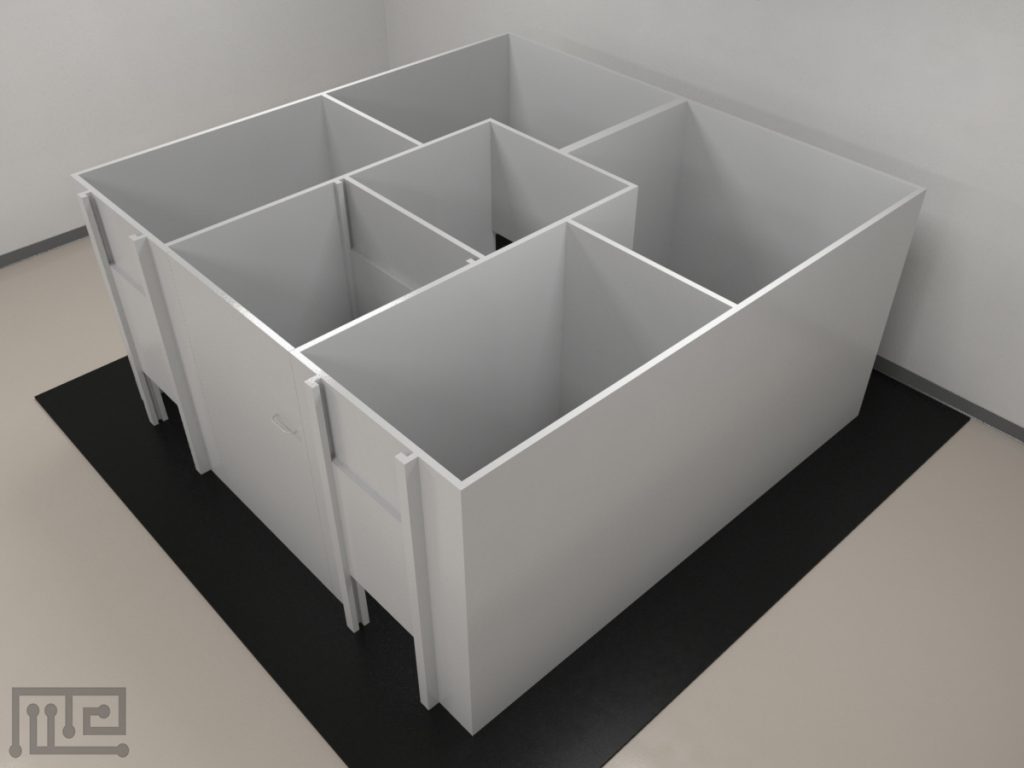The Dog T maze can be used to assess cognitive impairment, navigation task and also spatial cognition in dogs. It is constructed of white plastic panels. The entrance to the apparatus consists of a door, leading into the start compartment.
The apparatus contains three sliding panels remotely controlled by an experimenter; one panel permits access to the central compartment from the start compartment and the remaining two serves as exits at the end of each lateral arm.
Mazeengineers offers the Dog T maze.
Price & Dimensions
Dog T maze
$ 1990
+S&H- Length of maze: 3m
- Width of maze: 3m
- Height of maze: 1.5m
- Width of entrance door: 1m
- Length of start compartment: 1m
- Width of start compartment: 1m
- Length of central compartment: 1m
- Width of central compartment: 1m
- Length of lateral arm: 3m
- Width of lateral arm: 1m at their narrowest point
- Height of aperture at both exits: 0.8m
Documentation
Introduction
The Dog T-Maze is used in spatial navigation and memory tasks that assess cognitive abilities in dogs. The maze is a square-shaped arena that contains inner walls that form a “T” shaped maze. The longitudinal alley of the “T” shaped maze serves as the starting arm and two lateral arms as the choice arms. The start arm consists of a panel that creates a division between the starting area and decision point, and can be used for acclimatization or to include delays as per protocols. Additional panels are also equipped onto the ends of the lateral arms to create exits as needed.
Performances of dogs in spatial mazes such as the Radial Arm Maze have shown their ability to readily acquire spatial learning and memory tasks as well as their flexibility in spatial information processing (Craig et al., 2012; Macpherson & Roberts, 2010). Furthermore, dogs also share a similar pattern of age-related cognitive decline to that observed in humans (Schütt et al., 2016). The Dog T-Maze, thus, can be effectively used as a translational tool in learning and memory research. In contrast to other complex assays, the Dog T-Maze uses a two-choice paradigm that is effective enough to allow observation of cognitive dysfunctions. Generally, Dog T-Maze protocols task the subjects to learn the route that leads to the correct exit out of the maze. Behavioral flexibilities can also be evaluated in the maze using reversal learning protocols or protocols that involve delays.
Other T-Maze variations used in the study of learning and choice behaviors in other animals include the Rodent T-Maze, the Piglet T-Maze, the Zebrafish Bifurcating T-Maze, and the Ant T-Maze.
Apparatus and Equipment
The Dog T-Maze is a squared shaped apparatus that measures 3 m in width, 3 m in length, and 1.5 m in height. The walls of the maze are made of acrylic panels. The front wall of the apparatus contains a door (1 m wide) at the center, which serves as the entrance of the maze. The entrance leads to the starting arm, which is divided into a start compartment (1 x 1 m) and a central compartment (1 x 1 m) by a sliding panel. The central compartment contains two identical, symmetrical openings that lead to the lateral arms of the maze. The lateral arms are 3 x 1 m at their narrowest points and contain an aperture (0.8 m in height) at the ends, which serves as the exit. Sliding panels are equipped onto the exits, which can either keep them opened or closed.
Training Protocol
Clean the apparatus before and after every trial to prevent the influence of any odor cues from previous trials. Appropriately light the apparatus. A tracking and recording system such as the Noldus Ethovision XT can be used to assist with observations.
Direction-Determination Trial
Keep all the sliding panels of the maze closed. Lead the subject into the start compartment. Call the subject and immediately raise the start alley panel to initiate the task. Allow the subject to enter the central compartment and freely enter any of the two lateral arms. Keep the exit panel of the arm the subject chooses first closed. Allow the subject to navigate back into the central compartment to the other lateral arm. Once the subject is midway in the second lateral arm, raise the sliding panel of the exit door and allow the subject to exit the maze. Set the first arm entered by the subject as the incorrect arm and the arm from which it exits as the correct arm for all proceeding learning and memory trials.
Dog T-Maze Training Trials
Keep the exit panel of the correct arm open. Lead the subject into the start compartment and perform trials in the same manner as Direction-Determination Trials. Perform trials until the subject reaches the required learning criterion. Separate trials with a predetermined inter-trial interval.
Retention Test
Following a retention period after the Dog T-Maze training trials perform the retention trials. Keep the exit panels in both lateral arms open. Lead the subject into the start compartment and perform trials in the same manner as Direction-Determination trials. Conduct trials until the subject exits the apparatus through the correct lateral arm in at least 3 out of 4 trials.
Reversal Learning Task
After the subject completes Retention Trials, conduct Reversal Learning Trials to test the subject’s ability to modify previously acquired behavioral responses. Conduct trials in the same manner as the Dog T-Maze Task, however, keep the previously incorrect lateral arm’s exit open and the other exit panel closed.
Literature Review
Evaluation of the effect of sex on the spatial performance of dogs
Mongillo, Scandurra, D’Aniello, and Marinelli (2017) investigated the effect of sex and gonadectomy on the spatial performance of dogs using the Dog T-Maze. Sixty-four pet dogs of different breeds were used in the study and divided into four groups: 16 intact males (mean ± SD: 5.2 ± 1.7 years), 16 orchiectomized males (4.3 ± 1.7 years), 16 intact females (4.6 ± 1.9 years) and 16 ovariectomized females (5.3 ± 1.9 years). The dogs were tested for their ability to learn the Dog T-Maze task, retain the acquisition after 2 weeks, along with the reversal learning. Out of the 64 dogs tested, 40 dogs successfully completed all tasks on the Dog T-Maze. In the direction-determination trials, no differences were observed in latency to complete the task between intact dogs of different sex, intact and ovariectomized females or intact and orchiectomized males. In the learning task, it was observed that 56 out of 64 dogs successfully completed the task. Intact females reached the learning criterion in fewer trials and made fewer errors as compared to intact males and ovariectomized females. No significant differences were observed between intact and orchiectomized males in the number of errors made, the number of trials needed to complete the task, and in choice latency. In the memory test, 46 out of 56 dogs showed successful retention of the task with intact females displaying the best performance out of all treatment groups. In the reversal learning task, 40 out of 46 dogs successfully completed the task. No differences were found between intact females and males, intact and ovariectomized females, and intact and orchiectomized males in the number of trials to reach criterion, the number of errors made, and mean trial latency.
Investigation of the potential link between cognitive impairments and immunological parameters
Mongillo et al. (2015) investigated the relationships between age, cognitive decline, and the immune status in dogs. Forty-five healthy adults (N=16, age range: 2 – 7 years) and aged (N=29, age range: above 8 years) pet dogs of different breeds which included 20 intact males, 2 orchydectomised males, 4 intact females, and 19 ovariectomized females were used in the study. All dogs were initially tested for social attention in two attention tasks (15 minutes apart) that involved the dog observing their owner and a stranger (except in the last transit) and approaching the door their owner exited from. Thirty minutes following the social attention tasks, subjects were evaluated for their task acquisition, long-term (2 weeks) retention, and spatial reversal learning abilities in the Dog T-Maze. Dogs that were either unresponsive in the two attention tasks or unsuccessful in the spatial reversal task in the Dog T-Maze were classified as cognitively impaired. Based on the results, 4 out of the 16 adult dogs and 10 out of the 29 aged dogs were classified as cognitively impaired. After cognitive testing, subjects underwent a single blood collection for hematological analysis. Results indicated a lower peripheral CD4 lymphocyte number and higher monocyte number and percentage in aged dogs that did not perform the tasks successfully. No relationship between markers of oxidative stress and cognitive impairment was observed in all subjects.
Evaluation of the effect of age on spatial learning abilities of dogs
Mongillo et al. (2013) investigated spatial navigational abilities in forty-four pet dogs (18 males and 26 females) aged between range 3 to 12.5 years with the absence of Cognitive Dysfunction Syndrome or any other medical condition that could negatively impact the study. Cognitive testing was conducted on the Dog T-Maze, which included learning and memory retention training as well as reversal training. Results from the direction-determination trial indicated both right and left arms were similarly chosen by the subjects. In the learning task, it was observed that the learning criterion was achieved by 33 out of 44 subjects. The average age of the subjects that reached the learning criterion was 7.3±2.5 years, while the average age of the subjects that failed the task was 9.2±3.5 years. In the retention test, 27 out of 33 (mean age=7.1±2.5 years) subjects showed successful retention of the task after 2 weeks. The mean age of the unsuccessful subjects was 8.7±2.1 years. In the reversal learning task, it was observed that 20 out of 27 subjects passed the task. The mean age of the successful subjects was 6.2±2.0 years, while the unsuccessful subjects had a mean age of 9.4±2.2 years. Observation of the effect of age on the performance of the task indicated no effect of age on mean trial latency or duration measures in the learning and retention tasks. However, a significant effect of age was observed in the retention task in which older dogs committed significantly more errors. Overall results indicated that the task was rapidly acquired by the majority of the subjects, and dogs older than 8 years showed impairment in reversal learning abilities.
Data Analysis
The following can be observed using the Dog T-Maze:
- Number of times the subject entered the correct arm
- Number of times the subject entered the incorrect arm
- Decision latency (time in seconds from the owner’s call to a lateral arm choice)
- Trial duration (time in seconds from the lateral arm choice to exit from the apparatus)
- Total trial duration
- Number of errors made
Strengths and Limitations
Strengths
The Dog T-Maze is a simple two-choice apparatus that can be used to evaluate spatial navigation and memory abilities of dogs. The start arm and the ends of the lateral arms of the maze are equipped with sliding panels that allow manipulation of entries and exits. Additionally, the panel in the start arm divides it into a start area and a decision area. The start area can be used to acclimatize the subject prior to initiating trials or to induce delays in trials. The Dog T-Maze can be adapted as per the needs of different protocols to test behavioral flexibilities as well as other learning and memory-related tasks in dogs.
Limitations
Factors such as age, gender, and strain of the subject may affect task performance. The task is performed in a series of phases and may take a substantial amount of time. Exploratory behavior of the subjects may influence task performance. Unintentional stimuli may affect the way the subject performs the task.
Summary
- The Dog T-Maze can be used to test spatial navigation and memory in dogs.
- It is a square-shaped apparatus with internal walls that create the “T” shaped maze.
- The Dog T-Maze is equipped with sliding panels in the starting arm and the exit doors, which can be used to manipulate entries and exits in the maze.
References
- Craig, M., Rand, J., Mesch, R., Shyan-Norwalt, M., Morton, J., & Flickinger, E. (2012). Domestic dogs (Canis familiaris) and the radial arm maze: Spatial memory and serial position effects. Journal of Comparative Psychology, 126(3), 233–242.doi: 10.1037/a0025929
- Macpherson, K., & Roberts, W. A. (2010). Spatial memory in dogs (Canis familiaris) on a radial maze. Journal of comparative psychology, 124(1), 47. doi: 10.1037/a0018084
- Mongillo, P., Araujo, J. A., Pitteri, E., Carnier, P., Adamelli, S., Regolin, L., & Marinelli, L. (2013). Spatial reversal learning is impaired by age in pet dogs. Age, 35(6), 2273-2282. doi:10.1007/s11357-013-9524-0
- Mongillo, P., Bertotto, D., Pitteri, E., Stefani, A., Marinelli, L., & Gabai, G. (2015). Peripheral leukocyte populations and oxidative stress biomarkers in aged dogs showing impaired cognitive abilities. Age, 37(3), 39. doi:1007/s11357-015-9778-9
- Mongillo, P., Scandurra, A., D’Aniello, B., & Marinelli, L. (2017). Effect of sex and gonadectomy on dogs’ spatial performance. Applied animal behaviour science, 191, 84-89. doi:10.1016/j.applanim.2017.01.017
- Schütt, T., Helboe, L., Pedersen, L. Ø., Waldemar, G., Berendt, M., & Pedersen, J. T. (2016). Dogs with cognitive dysfunction as a spontaneous model for early Alzheimer’s disease: a translational study of neuropathological and inflammatory markers.Journal of Alzheimer’s Disease, 52(2), 433-449. doi: 10.3233/JAD-151085.
Request a quote
"*" indicates required fields




